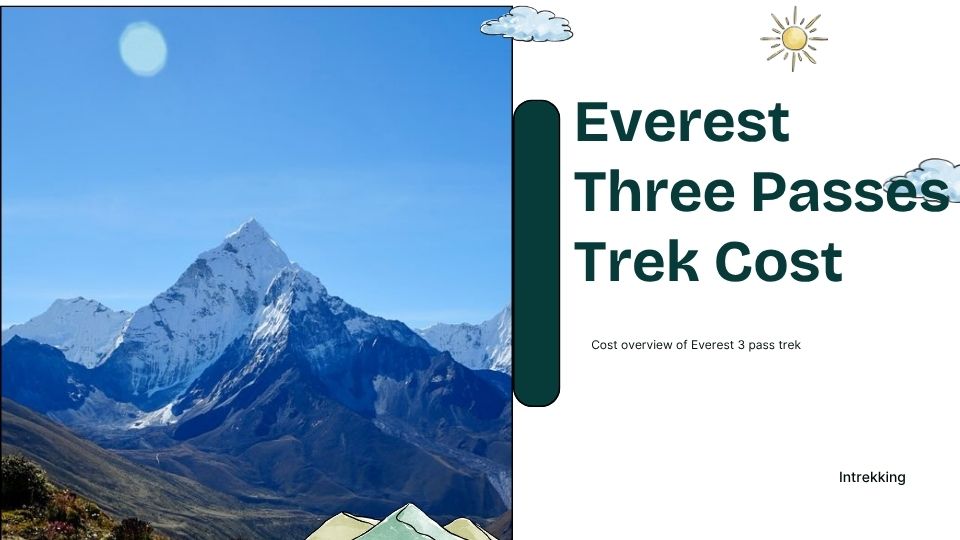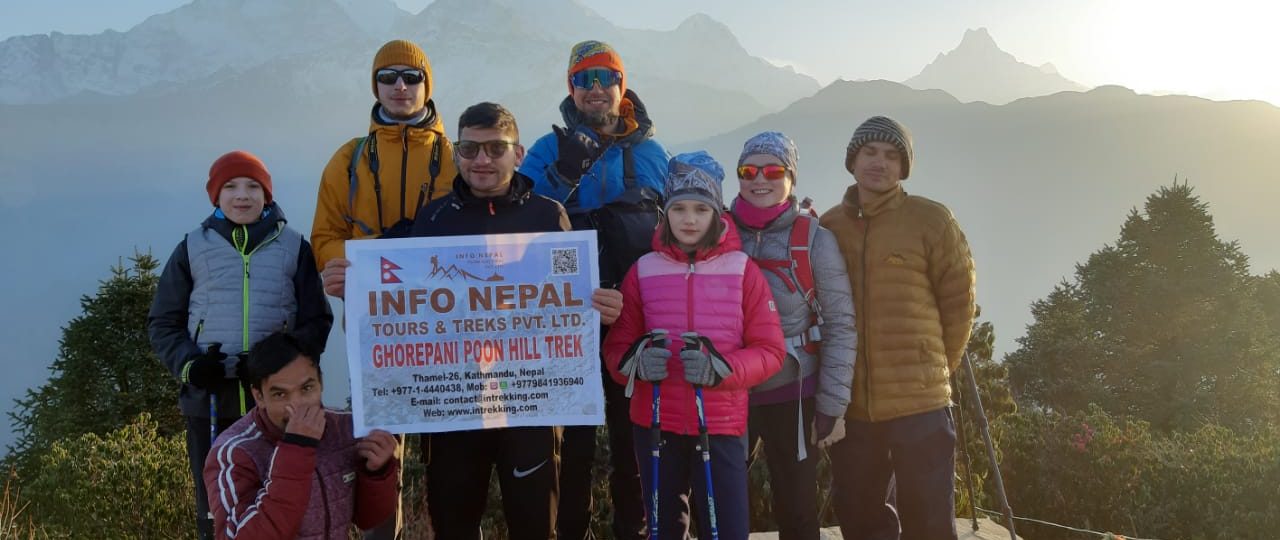
 Written By: Rajesh Neupane
Written By: Rajesh Neupane
Everest Three Passes Trek Cost
Enquiry Form
The small plane shakes as it lands on Lukla’s slanted runway. The wind roars, prayer flags dance, and your heartbeat syncs with the rhythm of the Himalayas. This is where your story begins — in the heart of the Everest Region, where every step costs effort, courage, and money. Many dream of completing the Everest Three Passes Trek, but only the well-prepared make it. Knowing the Everest Three Passes Trek cost beforehand helps you plan wisely, stay safe, and enjoy the journey without financial surprises.
This is not just a price list — it’s a field-tested insight into what it really takes to walk across Renjo La, Cho La, and Kongma La passes, the three icy gateways of Khumbu.
Plan your Trekking Journey with Intrekking and for Booking/enquiry contact us at:
email: [email protected]
Whatsapp: +9779841936940
1. Understanding the True Cost of Everest Three Passes Trek
The Everest Region trek cost depends on how you travel, where you sleep, and what level of comfort you seek. It’s a challenging route that circles the Everest Base Camp area, passing through remote highlands, glaciers, and Sherpa villages. Every meal, every night, and every step adds up — not just in money but in memory. Most trekkers spend USD 1,400 to 2,000 for a full 16–18 day trek.
This includes guides, porters, permits, flights, meals, and accommodation. Independent trekkers can trim the cost, but organized trips offer safety, insurance, and expert handling.
2. What’s Included in a Standard Trek Package
Reputable companies usually offer a package that bundles the essentials. For example, a 16-day Everest Three Passes Trek might include:
- Licensed English-speaking guide
- Porter support (1 porter for every 2 trekkers)
- Sagarmatha National Park entry and Khumbu Municipality permits
- Round-trip domestic flights (Kathmandu–Lukla–Kathmandu)
- Tea house accommodation
- Three meals a day (breakfast, lunch, dinner)
- First aid kit and oxygen backup
- Airport transfers and official paperwork
Excluded items often include international airfare, travel insurance, tips, and personal expenses.
Average package cost: USD 1,500–1,700 per person
This is the safest, most balanced approach for both cost and experience.
3. Nepal Tourist Visa Cost
Before stepping on Khumbu soil, you’ll need a visa. Tourist visas are available on arrival at Tribhuvan International Airport in Kathmandu.
Approximate fees:
15 days: USD 30
30 days: USD 50
90 days: USD 125
Most trekkers choose the 30-day visa, as the Everest Three Passes Trek can take over two weeks including travel and rest days. Make sure your passport is valid for at least six months.
4. Transportation Cost – The Gateway to Lukla
The journey truly begins with a short 35-minute flight from Kathmandu to Lukla. The tiny plane offers heart-stopping views of the Himalayan giants and the Dudh Koshi river valley.
Average one-way cost: USD 210–225 per person
Round-trip: USD 420–450
During peak seasons (March–May, October–November), prices remain stable but tickets sell out quickly. Off-season travelers may find discounted fares but face unpredictable weather delays. Alternative routes like Jiri or Phaplu to Lukla by jeep or bus cost much less (USD 80–100) but require two extra trekking days.
5. Accommodation Cost – From Cozy Tea Houses to High-Altitude Shelters
Every night on the trail feels different. In Namche Bazaar, you might enjoy a hot shower and Wi-Fi. In Lobuche or Dzongla, you’ll be thankful for a warm blanket and a flickering stove.
Tea houses (common): USD 7–10 per night
Hotels in Namche or Dingboche: USD 15–25 per night
Camping (rare): Free lodging, but costs extra for food and crew support
On a 16-20 day trek, expect to spend around USD 150–30000 on accommodation if booked independently. Packages often cover this cost within the total fee.
6. Food and Drink Costs – Fuel for Your Ascent
Food is your fuel, and prices rise with altitude. Everything in the Khumbu is carried up by porters, yaks, or helicopters.
Typical prices per meal:
Breakfast: USD 4–6
Lunch/Dinner: USD 7–10
Daily total: USD 20–25
Drinks:
Tea/Coffee: USD 2–3
Bottled water: USD 1.5–4
Soft drinks: USD 3–5
You’ll likely spend around USD 300–400 on food and drinks for the entire trek. Staying hydrated is vital — bring purification tablets to save money and plastic waste.
7. Trekking Permits and Entry Fees
You can’t walk freely in protected Himalayan regions without the proper permits. For the Everest Three Passes Trek, you’ll need two key documents:
1. Sagarmatha National Park Entry Permit – NPR 3,000 (about USD 23)
2. Khumbu Pasang Lhamu Municipality Permit – NPR 2,000 (about USD 15)
If you start your trek from Jiri or Salleri, you’ll also need a Gaurishankar Conservation Area Permit costing NPR 3,000 (USD 23). Always carry a few passport photos and copies of your passport for paperwork.
8. Guide and Porter Cost
The Khumbu trails are remote and rugged. Hiring a licensed guide ensures safety, cultural understanding, and local navigation. A porter eases your journey by carrying heavy bags, allowing you to walk light and strong.
Guide cost: USD 35–40 per day
Porter cost: USD 25–30 per day
Sharing porters between two trekkers reduces costs. For a Whole trek, expect:
Guide: ~USD 560-640
Porter: ~USD 400-500
Their wages sustain families in the highlands. Always tip generously at the end — about 10–15% of total cost is fair and appreciated.
9. Equipment and Gear Cost
The Himalayas test both your stamina and your gear. If you already own quality trekking equipment, your cost stays low. If not, you can rent in Thamel, Kathmandu, where outdoor shops line the streets.
Average rental prices (per day):
Sleeping bag: USD 1–2
Down jacket: USD 1–2
Trekking poles: USD 1
Buying everything new can exceed USD 400–600. Renting most gear can reduce that to around USD 50–70 total for the trek.
10. Travel Insurance and Emergency Evacuation
This is the single most crucial cost you should never skip. The Everest Three Passes route crosses 5,000 meters three times — at Kongma La, Cho La, and Renjo La. Altitude sickness and weather changes are unpredictable. Choose an insurance policy that covers:
- High-altitude trekking up to 6,000m
- Helicopter evacuation
- Medical treatment and repatriation
A good policy costs USD 100–150, depending on duration and coverage. Without insurance, a single helicopter rescue can cost USD 4,000–6,000 out of pocket.
11. Tips and Gratuities
Tipping is not mandatory, but it’s the Himalayan way of saying thank you. Guides and porters work tirelessly through snow, sun, and altitude for your safety.
A suggested guideline:
Guide: USD 10–15 per day (from group)
Porter: USD 8–10 per day (from group)
If you had excellent service, a little extra will mean the world to them.
12. Optional and Hidden Costs
Small things add up on the trail. Here are hidden costs many trekkers forget:
- Charging devices: USD 2–5 per hour at higher lodges
- Hot showers: USD 3–6 per shower
- Wi-Fi: USD 2–5 per session
- Toiletries and tissue rolls: USD 2–3 each
- Snacks and chocolate: USD 2–4 per bar
- Budget an extra USD 100–150 for these comforts.
13. Tips to Minimize Everest Three Passes Trek Cost
a. Trek in Shoulder Seasons
Prices drop slightly during early spring (February–March) and late autumn (late November–December). You’ll face fewer crowds, but prepare for colder weather.
b. Rent Gear Instead of Buying
If trekking once, renting saves hundreds. Thamel’s rental shops offer professional-grade equipment at a fraction of retail cost.
c. Travel in a Group
Sharing guides, porters, and rooms reduces your per-person expense dramatically.
d. Avoid Alcohol and Soda
These luxuries are expensive and dehydrate your body. Drink water or ginger tea instead — your body and wallet will thank you.
e. Carry Local Currency
Remote villages rarely accept cards. Carrying Nepali rupees avoids poor exchange rates and card fees.
14. Sample Budget Summary (Per Person)
Category Approx. Cost (USD)
- Visa & Permits: 100
- Domestic Flights: 420-450
- Guide & Porter: 900-1200
- Accommodation: 180-300
- Meals & Drinks 350
- Insurance 120
- Extras (Wi-Fi, showers, etc.) 100
Estimated Total ~2,170USD
By adjusting comfort level, sharing costs, or skipping certain luxuries, trekkers can bring the total closer to USD 1,500–2000.
15. Why Investing Properly Matters
The Khumbu trek cost isn’t only about numbers. Every dollar supports local lodges, schools, and Sherpa families. Paying fair prices ensures better safety, cleaner trails, and more sustainable tourism. Cutting corners might save money today but can cost dearly in emergencies. Invest in your well-being and in the community that makes this adventure possible.
16. A Journey Worth Every Penny
When you stand at the top of Renjo La Pass (5,360m), the view will silence you. Cho Oyu, Everest, and Makalu rise like frozen gods under the blue Himalayan sky. In that moment, no cost will feel too high.
The Everest Three Passes Trek is not just a route — it’s a transformation. Every rupee, every drop of sweat, every humble meal in a tea house becomes part of your story. Plan wisely, spend consciously, and let the Khumbu reward your preparation with memories that outlast a lifetime. Everest Three Passes Trek Cost – Complete Budget Guide for Trekking in the Everest Region